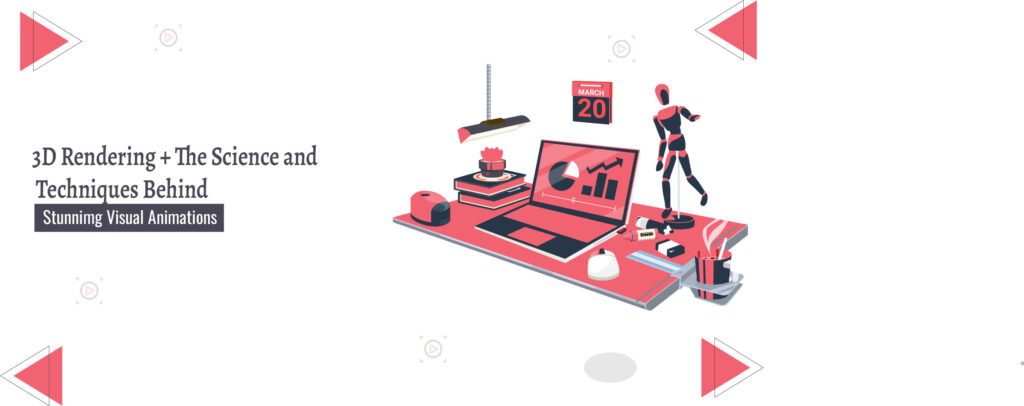
Curious about how those mesmerizing scenes in your favorite 3D animations come to life? You’re in for a treat! In this article, we’ll dive into the world of 3D rendering exploring the science, techniques, and innovations behind it.
3D rendering is the magic behind every visually captivating animated film, hyper-realistic video game, and immersive architectural visualization we see today. As of 2025, rendering has become not only more advanced but also more accessible, thanks to evolving hardware capabilities and innovative software. This comprehensive guide takes a deep dive into the realistic 3D rendering techniques, technologies, and workflows animators and studios are using to bring digital scenes to life.
In this blog, we will explore the core concepts that make great rendering possible, walk you through the differences in rendering engines, discuss the science of light and texture, and help you understand how to achieve photorealistic results using cutting-edge tools and strategies.
Word Count: 1,752 words
What Is 3D Rendering?
At its core, 3D rendering is the process of converting 3D models into 2D images or animations. This involves applying lighting, shading, textures, and other visual details to create a lifelike or stylized representation of a scene. It is the final step in the 3D animation pipeline and is responsible for the stunning visuals you see in modern movies, commercials, games, and architectural demos.
The Evolution of Rendering: Then vs. Now
In the early days, 3D rendering was limited by slow processing power and basic algorithms. Today, in 2025, real-time rendering and photorealism in 3D animation are the norm. Thanks to advanced GPU vs. CPU rendering techniques, artists can visualize complex scenes with near-instant feedback, enabling faster iteration and superior visual quality.
Realistic 3D Rendering Techniques
To create breathtaking visuals, professionals rely on several realistic 3D rendering techniques that bring depth, realism, and dynamic beauty to their work:
1. Global Illumination
This simulates how light reflects and bounces off surfaces, helping produce soft, indirect lighting that mimics real-world behavior.
2. Ambient Occlusion
A shading method that adds depth by darkening crevices and areas where light is naturally blocked.
3. Subsurface Scattering
Used especially for organic materials like skin or wax, this technique simulates how light penetrates a surface and scatters inside before exiting.
4. Depth of Field and Motion Blur
Borrowed from real-world photography and cinematography, these effects enhance realism by mimicking how lenses work.
5. Physically Based Rendering (PBR)
One of the most impactful developments in recent years, PBR models surfaces based on real-world physics, creating materials that react more naturally to lighting.
Lighting and Texturing in 3D Animation
Effective lighting and texturing in 3D animation is like the stage lighting of a theater production—it sets the tone, mood, and realism of the scene.
Lighting Techniques:
- Three-Point Lighting: Key, fill, and backlight create depth and dimension.
- HDRI Lighting: High-dynamic-range images act as 360-degree light sources, giving a natural environment-based look.
- Volumetric Lighting: Simulates light scattering through mediums like fog, smoke, or dust, adding drama and depth.
Texturing Techniques:
- Bump and Normal Mapping: Simulate surface detail without increasing geometry.
- Displacement Mapping: Actually modifies the surface geometry for ultra-realistic textures.
- Procedural Texturing: Creates patterns algorithmically, allowing infinite detail and flexibility.
Combining smart lighting with high-quality textures is the cornerstone of achieving a photorealistic look.
How to Achieve Photorealism in 3D Renders
Achieving photorealism isn’t just about technical skill—it’s an art. Here’s how you can bridge the gap between CG and reality:
1. Reference Real Life
Study real-world photography, cinematography, and environments. Observe how light reacts with different materials.
2. Master Material Creation
Use PBR materials and fine-tune properties like roughness, specularity, and metallic levels.
3. Use High-Resolution Assets
Textures, models, and displacement maps should be of the highest resolution for the best visual fidelity.
4. Calibrate Lighting Correctly
Use real-world units for lights and render settings for consistent, realistic outcomes.
5. Post-Processing
Color correction, chromatic aberration, and lens flares add finishing touches to make renders look like photos or film.
Best Software for 3D Rendering in 2025
With so many tools available, selecting the best software for 3D rendering in 2025 depends on your goals, budget, and project type. Here’s a list of top performers:
1. Blender (Cycles & Eevee)
- Free and open-source.
- Great for both real-time and offline rendering.
2. Autodesk Arnold
- Powerful ray-tracing engine.
- Ideal for film-quality renders.
3. Redshift
- GPU-accelerated renderer.
- Perfect for motion graphics and large scenes.
4. Octane Render
- Real-time feedback.
- One of the first path-tracing GPU renderers.
5. V-Ray
- Popular in architecture and product visualization.
- Offers incredible realism and flexibility.
6. Unreal Engine 5
- Game engine turned real-time rendering powerhouse.
- Excellent for cinematics and immersive environments.
Each of these programs supports ray tracing, PBR, and integration with industry-standard modeling and animation tools.
GPU vs. CPU Rendering: Which is Better for 3D Animation?
When choosing a rendering setup, it’s essential to understand GPU vs. CPU rendering:
CPU Rendering
- Uses the processor.
- Better for complex scenes with lots of geometry.
- Offers greater flexibility with certain renderers like Arnold.
GPU Rendering
- Uses the graphics card.
- Much faster for real-time previews.
- Ideal for freelancers, small studios, and fast-paced workflows.
In 2025, many professionals opt for hybrid systems, allowing users to take advantage of both technologies depending on their scene complexity and render needs.
Ray Tracing vs. Rasterization in 3D Rendering
These two rendering techniques have long battled for dominance. Understanding the differences helps in choosing the right approach.
Ray Tracing
- Simulates the actual path of light rays.
- Produces ultra-realistic lighting, shadows, and reflections.
- Requires powerful hardware and longer render times.
Rasterization
- Converts 3D data into pixels without simulating light rays.
- Much faster, used in real-time engines like game development.
- Lacks some of the photorealistic qualities but is optimized for speed.
Ray tracing vs. rasterization in 3D rendering is not a matter of one being better than the other—it’s about choosing the right tool for the job.
Additional Techniques to Improve Your Renders
- Denoising Algorithms: Clean up noisy renders without sacrificing detail.
- Render Layers & Passes: Separate lighting, shadows, and effects for greater control in post.
- Color Management: Use accurate color profiles for consistent results across devices.
Real-World Applications of 3D Rendering
3D rendering is used in many industries:
- Film & Animation: From Pixar to Marvel, rendering is the final polish.
- Gaming: Real-time rendering is crucial for immersive gameplay.
- Architecture: Helps visualize buildings before they are constructed.
- E-commerce: 3D product visualization is boosting online conversions.
- Medical & Scientific Visualization: Helps explain complex biological systems visually.
Rendering in the Cloud: A 2025 Standard
Cloud-based rendering farms are now standard. Services like AWS ThinkBox, Google Cloud Rendering, and GarageFarm allow studios to upload scenes and get renders back without investing in expensive infrastructure. This trend has made rendering more scalable, collaborative, and cost-effective.
Common Mistakes to Avoid
- Over-relying on Filters: Filters can’t fix poor lighting or textures.
- Ignoring the Scene Scale: Incorrect scale leads to lighting and shading errors.
- Skipping Render Tests: Always test low-resolution previews before final renders.
- Lack of Optimization: Unoptimized scenes increase render time and may crash.
The Future of 3D Rendering in 2025 and Beyond
In 2025, AI-assisted rendering tools are now mainstream. Machine learning models can predict lighting setups, auto-correct materials, and even enhance render speed by filling in gaps in data. Tools like NVIDIA’s DLSS and OptiX AI Denoiser are redefining what’s possible in terms of speed and quality.
We’re also seeing the merging of virtual production with real-time rendering in tools like Unreal Engine, which now lets filmmakers visualize entire scenes live on LED walls.
Final Thoughts
Whether you’re a beginner or a seasoned animator, understanding the science and techniques behind stunning visual animations is essential for success in the 3D animation world. Mastering realistic 3D rendering techniques, understanding the power of lighting and texturing in 3D animation, and choosing the best software for 3D rendering in 2025 can elevate your work to new heights.
From the basics of ray tracing vs. rasterization in 3D rendering to deciding between GPU vs. CPU rendering, this knowledge empowers you to produce breathtaking visuals that captivate and inspire.
The future of animation is bright—and beautifully rendered.
Frequently Asked Questions (FAQ’s)
What is a 3D rendering engine?
A 3D rendering engine is a crucial component of 3D software that handles the complex calculations required to produce the visual output of a 3D scene. Essentially, it processes 3D models along with information related to cameras, textures, lighting, and shading, transforming them into a collection of pixels that form an image.
These rendering engines leverage the computational capabilities of the host’s CPU or GPU to execute their calculations efficiently. Currently, a variety of rendering engines are available in the market, which can come as proprietary engines bundled with software packages, plug-ins, or standalone applications. Within the 3D animation industry, certain rendering engines are particularly popular and widely used.
What are the best rendering engines available?
Today, a variety of rendering engines are available, including Unreal Engine, Arnold, Redshift, Renderman, V-Ray, and Corona. At Animotions Studio, we primarily use:
1. Arnold
Arnold is an advanced ray-tracing engine ideal for animated films and visual effects, available in CPU and GPU formats. It’s widely used by studios like Sony Pictures Imageworks and integrates seamlessly with Maya and 3D Max.
Key Features:
- Photo-realistic renders
- User-friendly
- Memory efficient
- Easy to switch to
2. Redshift
Redshift is a GPU-based renderer designed for faster 3D art creation. Developed by industry veterans, it’s popular among studios and creative professionals for high-end production rendering.
Key Features:
- Render farm support
- Easy to use
- Lightning-fast rendering
- Versatile and photo-realistic results
- Seamless integration
What is the difference between OpenGL and Vulkan?
- OpenGL: A versatile API used for 2D and 3D graphics on multiple platforms. It abstracts hardware details, making it easier for developers but sometimes introducing performance overhead.
- Vulkan: Provides more direct control over hardware, allowing for better performance and efficiency. It requires developers to manage more details but reduces driver overhead. Vulkan’s explicit control can lead to enhanced performance and more efficient resource use.
What are rendering engines, and how do they differ from APIs?
Rendering engines are built on top of rendering APIs and use them to implement specific rendering techniques and optimizations. While APIs like OpenGL and Vulkan provide the foundational tools for interacting with hardware, rendering engines like RenderMan, V-Ray, and Redshift focus on creating high-quality images and animations using those tools. Engines offer more specialized functionalities tailored to different types of rendering tasks.
What are some notable rendering engines, and what are their strengths?
- RenderMan: Known for its advanced shading tools and global illumination capabilities, ideal for high-end cinematic productions. It excels in creating realistic materials and lighting.
- V-Ray: Offers realistic lighting and material libraries with support for both CPUs and GPUs, balancing speed and quality. It provides versatile solutions for various rendering needs.
- Redshift: Recognized for its fast rendering speeds and real-time previews, suitable for film and motion graphics. Its speed and efficiency make it a preferred choice for quick turnarounds.
- Cycles: Blender’s rendering engine blends realism with user-friendly features, offering real-time previews and strong light control. It integrates seamlessly with Blender’s modeling tools for a cohesive workflow.





